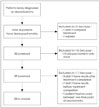1. Shusterman S, George RE. Neuroblastoma. In : Orkin SH, Nathan DG, Ginsburg D, Look AT, Fisher DE, Lux SE, editors. Nathan and Oski's Hematology and Oncology of Infancy and Childhood. 8th ed. Philadelphia: Saunders Elsevier;2014. p. 1675–1713.
2. Cha ES, Kong KA, Moon EK, Khang YH, Lee WJ. Childhood cancer mortality and birth characteristics in Korea: a national population-based birth cohort study. J Korean Med Sci. 2011; 26:339–345.

3. Smith MA, Seibel NL, Altekruse SF, Ries LA, Melbert DL, O'Leary M, et al. Outcomes for children and adolescents with cancer: challenges for the twenty-first century. J Clin Oncol. 2010; 28:2625–2634.

4. Haupt R, Fears TR, Robison LL, Mills JL, Nicholson HS, Zeltzer LK, et al. Educational attainment in long-term survivors of childhood acute lymphoblastic leukemia. JAMA. 1994; 272:1427–1432.

5. Boulad F, Sands S, Sklar C. Late complications after bone marrow transplantation in children and adolescents. Curr Probl Pediatr. 1998; 28:273–297.

6. Schwartz CL. Long-term survivors of childhood cancer: the late effects of therapy. Oncologist. 1999; 4:45–54.

7. Fidler MM, Frobisher C, Guha J, Wong K, Kelly J, Winter DL, et al. Long-term adverse outcomes in survivors of childhood bone sarcoma: the British Childhood Cancer Survivor Study. Br J Cancer. 2015; 112:1857–1865.

8. Fuemmeler BF, Elkin TD, Mullins LL. Survivors of childhood brain tumors: behavioral, emotional, and social adjustment. Clin Psychol Rev. 2002; 22:547–585.
9. Font-Gonzalez A, Feijen EL, Sieswerda E, van Dulmen-den Broeder E, Grootenhuis M, Maurice-Stam H, et al. Social outcomes in adult survivors of childhood cancer compared to the general population: linkage of a cohort with population registers. Psychooncology. 2016; 25:933–941.

10. Schwartz CE, Feinberg RG, Jilinskaia E, Applegate JC. An evaluation of a psychosocial intervention for survivors of childhood cancer: paradoxical effects of response shift over time. Psychooncology. 1999; 8:344–354.

11. Hudson MM, Mertens AC, Yasui Y, Hobbie W, Chen H, Gurney JG, et al. Health status of adult long-term survivors of childhood cancer: a report from the Childhood Cancer Survivor Study. JAMA. 2003; 290:1583–1592.

12. Surbone A, Annunziata MA, Santoro A, Tirelli U, Tralongo P. Cancer patients and survivors: changing words or changing culture? Ann Oncol. 2013; 24:2468–2471.

13. Marzorati C, Riva S, Pravettoni G. Who is a cancer survivor? A systematic review of published definitions. J Cancer Educ. 2016; 02. 08. [Epub]. DOI:
10.1007/s13187-016-0997-2.

14. Park H, Gwak G, Park G. K-WPPSI Manual. Special Education. Seoul: 1995.
15. Kwak K, Park H, Kim C. K-WISC-III (Korean Wechsler Intelligence Scale for Children-III). Special Education. Seoul: 2001.
16. Gwak G, Oh S, Kim C. K-WISC-IV (Korean Wechsler Intelligence Scale for Children-IV). Manual for experts. Seoul: Hakjisa;2011.
17. Yeom T, Park Y, Oh K, Kim J, Lee Y. K-WAIS Guideline. Seoul: Korea Guidance;1992.
18. Edgar AD. Vineland Social Maturity Scale: condensed manual of directions. Minnesota: American Guidance Service;1965.
19. Kim S, Kim O. Social maturity scale. Seoul: Joongang Aptitude;1985.
20. Ha EH, O GG, Lee HR, Hong GU. Reconstruction of the behavior problem scales of the Korean CBCL. Seoul J Psychiatry. 1995; 20:245–253.
21. Cho SM, Park HY, Kim JH, Hong CH, Hwang ST. A standardization study of The Korean Personality Rating Scale for Children (KPRC). Korean J Clin Psychol. 2006; 25:825–848.
22. Zeltzer LK, Recklitis C, Buchbinder D, Zebrack B, Casillas J, Tsao JC, et al. Psychological status in childhood cancer survivors: a report from the Childhood Cancer Survivor Study. J Clin Oncol. 2009; 27:2396–2404.

23. Nathan PC, Ness KK, Greenberg ML, Hudson M, Wolden S, Davidoff A, et al. Health-related quality of life in adult survivors of childhood Wilms tumor or neuroblastoma: a report from the childhood cancer survivor study. Pediatr Blood Cancer. 2007; 49:704–715.

24. Carpentieri SC, Diller LR. Neuropsychological resiliency after treatment for advanced stage neuroblastoma. Bone Marrow Transplant. 2005; 35:1117–1122.

25. Notteghem P, Soler C, Dellatolas G, Kieffer-Renaux V, Valteau-Couanet D, Raimondo G, et al. Neuropsychological outcome in long-term survivors of a childhood extracranial solid tumor who have undergone autologous bone marrow transplantation. Bone Marrow Transplant. 2003; 31:599–606.

26. Woodgate RL, Tailor K, Yanofsky R, Vanan MI. Childhood brain cancer and its psychosocial impact on survivors and their parents: a qualitative thematic synthesis. Eur J Oncol Nurs. 2016; 20:140–149.








 PDF
PDF ePub
ePub Citation
Citation Print
Print




 XML Download
XML Download